ASSEMBLIES OF GOD (AOG) TIMELINE
1885-1900 Healing and Holiness revivals swept through the U.S., laying a foundation for the emergence of Pentecostalism.
1901 Agnes Ozman spoke in tongues in a prayer meeting led by Charles Fox Parham (1873-1929) in Topeka, Kansas.
1906-1909 The Azusa Street Revival in Los Angeles was launched by William Joseph Seymour (1870-1922), African American son of former slaves. The revival is commonly regarded as the birthplace of the Pentecostal movement.
1913 Eudorus N. Bell, Howard Goss, Daniel C.O. Opperman, Archibald P. Collins, and Mack M. Pinson initiated a call to a general council.
1914 The First General Council of the Assemblies of God was held in Hot Spring, Arkansas.
1916 The Fourth General Council of the Assemblies of God that was held in St. Louis adopted the Statement of Fundamental Truths.
1920 Women were granted permission to vote at General Councils.
1935 Women were granted full ordination by the AG, permitting them to administer the ordinances of baptism and communion “when such acts are necessary.”
1942 The Assemblies of God joined the newly founded National Association of Evangelicals.
1948 The all-white Pentecostal Fellowship in North America (PFNA) was established.
Late 1940s The New Order of the Latter Rain (‘Latter Rain Revival’) sought to revitalize Pentecostalism.
1960s The Charismatic Movement in Mainline Protestant and Catholic Churches experienced significant growth.
1962 David du Plessis (“Mr. Pentecost”) was stripped of AG ministerial credentials
1989 The World Pentecostal Assemblies of God Fellowship, representing national Pentecostal churches that were historically connected to the AG, was founded.
1993 The World Pentecostal Assemblies of God Fellowship became the World Assemblies of God Fellowship.
1994 The “Memphis Miracle” and racial reconciliation; the all-white Pentecostal Fellowship of North American (PFNA) was replaced with the integrated Pentecostal Charismatic Churches of North America (PCCNA).
2006 The AG established the Office of Hispanic Relations; the Spanish version of the Pentecostal Evangel (Evangelio Pentecostal) began publication.
FOUNDER/GROUP HISTORY
The seeds for the General Council of the Assemblies of God (AG) were planted by the affective experiences common to the religious revivals that swept through the American heartland in the twilight of the nineteenth and early twentieth centuries (Poloma 1989; Poloma and Green 2010). Revivalists claimed not only personal spiritual transformation but divine empowerment for Christian service. This empowerment was frequently marked by strange physical manifestations, reported miracles, new theologies, and a burning desire to spread the gospel before Jesus returns. Many would separate from their old denominations (or were kicked out) as they embraced the “‘four-fold’ gospel of personal salvation, Holy Ghost baptism, divine healing, and the Lord’s soon return.” It became the theological base for scores of small sects, including the AG (Wacker 2001:1).
The fourfold gospel demanded more than an intellectual assent. Reports of salvation, repenting and accepting Jesus as the divine reconciler, were filled with stories of unusual encounters with the divine. Baptism in the Holy Spirit, an intense experience available to all who had experienced salvation, was marked by the peculiar “evidence” of speaking in tongues (glossolalia). Thus, at the heart of this fourfold gospel were paranormal experiences (divine healing, prophecy, miracles, speaking in tongues and other signs and wonders) biblically reported by the early Christian church. Such experiences were believed to empower the believer for the mission of spreading the gospel throughout the world in the “last days” before the righteous were raptured into heavens and Jesus would come to judge the unrighteous.
America has always had its revivals accompanied by the turbid emotionalism of heart-felt religion, accounts of which seemed to intensify as the nineteenth century came to a close (McClymond 2007). To the countless emotional stories of personal salvation that marked the first four decades of the nineteenth century were added testimonies of miraculous healings in the latter half. Healing evangelists were modeling divine healing in revivals and teaching that Jesus had given his followers the commission and power to “heal the sick.” Many of these nineteenth-century healing revivalists and their followers would come to identify with Pentecostalism, a twentieth century religious movement that now accounts for more than one half billion Christians worldwide.
Although historians agree that pentecostal revivals occurred in parts of the world other than the United States, most also 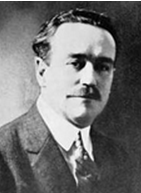 concede that the U.S. was one of, if not the major player in the birth of global Pentecostalism. They further concede that Charles Fox Parham provided a critical theological plank that differentiated Pentecostalism from other Protestant revivals and from the fundamentalist movement. Clearly the healing movement of the late nineteenth century paved the way for Pentecostal experiences, but not all who embraced divine healing would become Pentecostal. It was Parham’s theological linking of the “baptism in the Holy Ghost” to the “evidence” of speaking in tongues (glossolalia) that separated Pentecostals from critics who did not accept the validity of equating what they pejoratively labeled “gibberish” with biblical accounts of “speaking in tongues.” In 1901 Agnes Ozman, a student at Parham’s College of Bethel, a Bible school for adults, added credence to Parham’s theology when she was heard to speak in tongues, an event that many contend launched the Pentecostal movement (Seymour, 2012; Hollenweger 1997; Robeck 2006).
concede that the U.S. was one of, if not the major player in the birth of global Pentecostalism. They further concede that Charles Fox Parham provided a critical theological plank that differentiated Pentecostalism from other Protestant revivals and from the fundamentalist movement. Clearly the healing movement of the late nineteenth century paved the way for Pentecostal experiences, but not all who embraced divine healing would become Pentecostal. It was Parham’s theological linking of the “baptism in the Holy Ghost” to the “evidence” of speaking in tongues (glossolalia) that separated Pentecostals from critics who did not accept the validity of equating what they pejoratively labeled “gibberish” with biblical accounts of “speaking in tongues.” In 1901 Agnes Ozman, a student at Parham’s College of Bethel, a Bible school for adults, added credence to Parham’s theology when she was heard to speak in tongues, an event that many contend launched the Pentecostal movement (Seymour, 2012; Hollenweger 1997; Robeck 2006).
It is fair to say, however, that Charles Parham might not have had a major place in the history of Pentecostalism without William Joseph Seymour, the African American pastor of the Azusa Street Mission in Los Angeles. Seymour, the son of former slaves (born in 1870 in southern Louisiana) was involved in nineteenth century revivals emanating 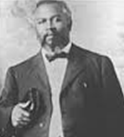
from the Wesleyan Holiness Movement between 1895 and 1905. During a visit to Houston in 1905, Seymour came into contact with Parham, and in January, 1906 Seymour would return to Houston where he enrolled in a six week course at Parham’s Bible school. [Because of segregation laws, the black Seymour sat in the hallway while white students were enjoying the lectures in an adjoining classroom.] Seymour went to Los Angeles in February, 1906 in response to a request by a leader of a small Baptist storefront mission that had embraced the teachings of the holiness movement. After Seymour presented Parham’s controversial teachings on Spirit baptism and tongues, he found himself locked out of the church. For several weeks Seymour was forced to limit his teachings to a house where he was staying on Bonnie Brae Street. There a seedling revival erupted when people began experiencing the baptism and tongues (Seymour 2012; Blumhofer and Armstrong 2002). To accommodate the greater numbers coming to the meeting, the group relocated at a former Methodist church on Azusa Street in April, 2006 (Seymour 2012; Bartleman 2012). The meeting on Bonnie Brae Street would soon morph into the Azusa Street Revival, arguably the most important event in the early development of the global Pentecostal movement. Although the secular press did not take kindly to the revival, it did take note. Church historian Cecil M. Robeck (2006:1) opens his excellent book on the Azusa Street Revival with the following colorful, if pejorative, news report from the Los Angeles Herald that depicts the Revival through the eyes of the reporter:
All classes gathered in the temple last night. There were big Negroes looking for a fight, there were little fairies dressed in dainty chiffon who stood on the benches and looked on with questioning wonder in their baby-blue eyes. There were cappers from North Alameda Street, and sedate dames from West Adams Street. There were all ages, sexes, colors, nationalities and previous conditions of servitude. The rambling old barn was filled and the rafters were so low that it was necessary to stick one’s nose under the benches to get a breath of air.
It was evident that nine out of every ten persons present was there for the purpose of new thrills. This was a new kind of show in which the admission was free—they don’t even pass the hat at the Holy Rollers’ meeting—and they wanted to see every act to the drop of the curtain. They stood on benches to do it. When a bench wasn’t handy, they stood on each other’s feet.
From 1906 through1909 Seymour’s Azusa Street Mission would become a focus of religious news not only for the faithful in Los 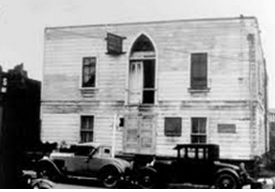 Angeles, but for countless people across the globe. Accounts and myths about the revival spread long after the revival fires on Azusa Street were reduced to a flickering flame. Many who were touched by the revival would carry the Parham’s theology and Seymour’s revival throughout the United States and beyond. Upon visiting Azusa Street, however, Parham, rejected the revival because of what he considered to be the “extremes” in the revival that he credited to “Negro” religion (Bartleman 2012).
Angeles, but for countless people across the globe. Accounts and myths about the revival spread long after the revival fires on Azusa Street were reduced to a flickering flame. Many who were touched by the revival would carry the Parham’s theology and Seymour’s revival throughout the United States and beyond. Upon visiting Azusa Street, however, Parham, rejected the revival because of what he considered to be the “extremes” in the revival that he credited to “Negro” religion (Bartleman 2012).
Although the revival fires waned by 1909, Seymour continued to pastor the Mission until his death in 1922. But as we have suggested, this was hardly the end of the story. Revival fires carried by Azusa Street pilgrims to myriads of congregations and scores of small sects both nationally and internationally (Bartleman 2012; Seymour 2012). Its paranormal religious experiences also pentecostalized some existing denominations. Most noteworthy was the pentecostalization of the Church of God in Christ (COGIC), still predominantly African American and now the fifth largest American denomination.
But many white revivalists were turned off to what they regarded as the extremes of the Azusa Street Mission remained affiliated with Charles Parham’s Apostolic Faith Movement (AFM). By 1913, however, some affiliates of the AFM became concerned about whether the network had become too organized under Parham’s leadership to allow for the vitality of an “end-times revival.” As AG historian Edith Blumhoffer (1993:116) described it: “Troubled by excess yet committed to life ‘in the Spirit,’ they decided to explore the advantage of cooperating as a loosely structured network that would preserve their autonomy but also provide a forum for consideration of mutual concerns.” [An interesting lived-account of this period can be found in Ethel Goss’s (1958) book penned by her husband Howard Goss about his involvement in the revival and the founding of the Assemblies of God.]
In 1913, five ministers (Eudorus N. Bell, Howard Goss, Daniel C.O. Opperman, Archibald P. Collins, and Mack M. Pinson, men who were affiliated with the loosely organized white Churches of God in Christ) initiated a call to a “general council” through various Pentecostal publications. Within the next three months the names of twenty nine other leaders representing different parts of the country and pentecostal perspectives were added to this original list. On April 6, 1914, the first meeting of the General Council, hosted by Howard Goss and his congregation, opened at the Grand Old Opera House in Hot Springs, Arkansas, where Goss and his wife settled and began an Assembly in 1912. E. N. Bell [who, according to Goss’ (1958) account collaborated closely with him] and J. R. Flower were appointed as chairman and secretary (Blumhoffer 1989). Although still wary of formal organization and decreed doctrine, those gathered sought a greater degree of cooperation in missionary activities, better business practices in their use of existing resources, and the establishment of a Bible training center. Of this endeavor to bring some order and accountability to the newly emerging Pentecostal movement, Goss (1958; chapter 27) would write:
As our numbers increased, the influx brought with it leaders who did not believe in organization at all; some even preached that anything of that nature (when committed to paper) was of the devil. Opposing this viewpoint was the definite system existing in the New Testament church under the Apostles. As we were all inexperienced, we were carefully testing every step, lest we somehow lose our precious fellowship with God.
As he continued his account Goss (1958; chapter 28) commented, “The smile of God seemed ot be on this union of many segments.” He went on to explain:
Whatever adjustments were needed were quickly, easily, and sweetly settled to everyone’s satisfaction. When those among us, who had doubted that the Conference would work out satisfactorily, saw how easily God had carried us past the shoals and hidden snags, they felt a mounting confidence in God and decided to co-operate. I think that what we Pentecostal people want to know, anyway, is that God is in any undertaking, and if He is, we are satisfied.
But despite perceptions of divine approval not all was well in this emergent network that eschewed both doctrine and structure. By 1916 the AG would lose an approximated quarter of its supporters due to an unacceptable “heresy” known as the “New Issue” that questioned the doctrine of the divine trinity. Although the initial two General Councils had been reluctant to deal with potentially divisive doctrine, the leaders were now forced to rethink the need for a basic statement of belief. Contributing more fuel to the doctrinal fire was the growing controversy over whether speaking in tongues was in fact “evidence” of Spirit baptism, as Parham and Seymour had taught (Blumhoffer and Armstrong 2002). The fourth General Council of the Assemblies of God held in St. Louis in 1916 would affirm Trinitarian theology within a doctrinal statement that adopted a list of sixteen “fundamentals.” The identity it espoused was “fundamentalism with a difference.” The two named points of “difference,” divine healing by the atonement and speaking in tongues as evidence of Spirit baptism, paradoxically would make the AG not only distinct from but also anathema to the twentieth century fundamentalist movement. Pentecostals, including members of the AG, became the target of the World’s Christian Fundamentals Association (WCFA), as illustrated by its resolution stating the WCFA was “unreservedly opposed to Modern Pentecostalism, including the speaking in unknown tongues, and the fanatical healing known as general healing in the atonement” (Blumhoffer 1993:159-60).
By 1920, a basic foundation had been laid by congregational leaders that proved to serve well the U.S. Assemblies of God as well as an emerging global network of AG congregations, which in 1993 would become known as the World Assemblies of God Fellowship. [The AG in the U.S. is but one of more than 150 national fellowships in the world’s largest Pentecostal network with over 65 million adherents .] Although originally rejected by fundamentalist congregations and isolated from other conservative denominations and sects (including other Pentecostal groups), the AG quietly continued on a path of steady growth. In 1942, the AG accepted an invitation to join the newly formed National Association for Evangelicals (NAE), a conservative umbrella organization that was able to overlook the doctrinal “differences” of glossolalia and healing. Despite some internal opposition within the AG to joining the NAE, leaders of the AG “embraced the vision of strength through unity” promised by this new evangelical organization that had tempered Fundamentalism’s antipathy toward Pentecostalism (Blumhofer 1993:184).
DOCTRINES/BELIEFS
Despite their initial resistance to a doctrinal statement, early leaders felt forced to adopt a common statement of faith in order to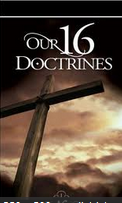 confront what they regarded as major heresy. The Statement of Fundamental Truths (SFT) adopted in 1918 is a description of sixteen doctrinal statements that drew heavily on early fundamentalist confessions of faith. The AG founders added “healing by the atonement” and tongues as “initial evidence” providing a pentecostal twist to fundamentalist beliefs. The following is a summary of the 16 Fundamental Truths as presented by the denomination, as “nonnegotiable tenets of faith that all Assemblies of God churches adhere to” (Assemblies of God n.d.).
confront what they regarded as major heresy. The Statement of Fundamental Truths (SFT) adopted in 1918 is a description of sixteen doctrinal statements that drew heavily on early fundamentalist confessions of faith. The AG founders added “healing by the atonement” and tongues as “initial evidence” providing a pentecostal twist to fundamentalist beliefs. The following is a summary of the 16 Fundamental Truths as presented by the denomination, as “nonnegotiable tenets of faith that all Assemblies of God churches adhere to” (Assemblies of God n.d.).
- WE BELIEVE… The Scriptures are Inspired by God and declare His design and plan for mankind.
- WE BELIEVE… There is only One True God–revealed in three persons…Father, Son, and Holy Spirit (commonly known as the Trinity).
- WE BELIEVE… In the Deity of the Lord Jesus Christ. As God’s son Jesus was both human and divine.
- WE BELIEVE…though originally good, Man Willingly Fell to Sin–ushering evil and death, both physical and spiritual, into the world.
- WE BELIEVE… Every Person Can Have Restored Fellowship with God Through ‘Salvation’ (trusting Christ, through faith and repentance, to be our personal Savior). [1 of 4 cardinal doctrines of the AG]
- WE BELIEVE…and practice two ordinances—(1) Water Baptism by Immersion after repenting of one’s sins and receiving Christ’s gift of salvation, and (2) Holy Communion (the Lord’s Supper) as a symbolic remembrance of Christ’s suffering and death for our salvation.
- WE BELIEVE… the Baptism in the Holy Spirit is a Special Experience Following Salvation that empowers believers for witnessing and effective service, just as it did in New Testament times. [1 of 4 cardinal doctrines of the AG]
- WE BELIEVE… The Initial Physical Evidence of the Baptism in the5 Holy Spirit is ‘Speaking in Tongues,’ as experienced on the Day of Pentecost and referenced throughout Acts and the Epistles.
- WE BELIEVE… Sanctification Initially Occurs at Salvation and is not only a declaration that a believer is holy, but also a progressive lifelong process of separating from evil as believers continually draw closer to God and become more Christlike.
- WE BELIEVE… The Church has a Mission to seek and save all who are lost in sin. We believe ‘the Church’ is the Body of Christ and consists of the people who, throughout time, have accepted God’s offer of redemption (regardless of religious denomination) through the sacrificial death of His son Jesus Christ.
- WE BELIEVE… A Divinely Called and Scripturally Ordained Leadership Ministry Serves the Church. The Bible teaches that each of us under leadership must commit ourselves to reach others for Christ, to worship Him with other believers, to build up or edify the body of believers–the Church and to Meet human need with ministries of love and compassion.
- WE BELIEVE… Divine Healing of the Sick is a Privilege for Christians Today and is provided for in Christ’s atonement (His sacrificial death on the cross for our sins). [1 of 4 cardinal doctrines of the AG]
- WE BELIEVE…in The Blessed Hope—When Jesus Raptures His Church Prior to His Return to Earth (the second coming). At this future moment in time all believers who have died will rise from their graves and will meet the Lord in the air, and Christians who are alive will be caught up with them, to be with the Lord forever. [1 of 4 cardinal doctrines of the AG]
- WE BELIEVE…in The Millennial Reign of Christ when Jesus returns with His saints at His second coming and begins His benevolent rule over earth for 1,000 years. This millennial reign will bring the salvation of national Israel and the establishment of universal peace.
- WE BELIEVE… A Final Judgment Will Take Place for those who have rejected Christ. They will be judged for their sin and consigned to eternal punishment in a punishing lake of fire.
- WE BELIEVE…and look forward to the perfect New Heavens and a New Earth that Christ is preparing for all people, of all time, who have accepted Him. We will live and dwell with Him there forever following His millennial reign on Earth. ‘And so shall we forever be with the Lord!’
The Assemblies of God also periodically releases statements on various issues not addressed in the SFT. Position papers cover a wide range of topics dealing with “biblical, theological and social concerns.” They include discussing proscribed behaviors (e.g., abstinence from alcohol; assisted suicide and abortion; divorce and remarriage; gambling; homosexuality); advise on questionable neo-pentecostal teachings (e.g., position of “prophets and apostles” in church organizations; demon possession and demonology; and “positive confession” (presuming to know the will of the divine and verbally professing the prayer need met by persistent positive professions rather than prayer). Position papers also have been written clarify other theological issues as they arise (e.g., creationism; inerrancy of scripture; and the rapture of the church). Position papers are not generally considered official positions of the AG, unless formal approval is requested by the Executive Presbytery and approved by the General Council.
The journey of AG doctrine from its original 1914 stance that tolerated doctrinal ambiguities to adopting the doctrinal SFT in 1918 is illustrated by its stance on baptism in the Holy Spirit. As succinctly summarized by AG historian C. M. Robeck (2003:170): “until late 1918, the Assembles of God was willing to tolerate ambiguity on the subject … with the adoption of the Statement of Fundamental Truths, however, the Assemblies of God had begun to close the door on differences of opinion.” AG has continued to closely align with Evangelical issues and doctrine while perhaps inadvertently distancing itself from “the vibrancy of an encounter with the living God” that has fueled the fires of the ongoing Pentecostal movement (Rybarczyk 2007: 8). This journey from primitivism to pragmatism (Wacker 2001) is reflected in AG rituals and practices.
RITUALS/PRACTICES
The worldview of the early Pentecostals accorded ideological legitimacy to the paranormal experiences reported in biblical times and restored them to a normative position in the twentieth-century Christianity. Although glossolalia and divine healing became the pivotal experiential doctrines in the AG, prophecy, miracles and demonic exorcisms were also part and parcel of the Pentecostal package. More controversial were the strange physical manifestations that generated the pejorative label “Holy Rollers” ascribed by outsiders to Pentecostal believers who sometimes fell in a faint to the floor, jumped pews, violently jerked and shook, laughed, barked or rolled in the aisles under the alleged influence of the Holy Spirit (Seymour 2012; see also Poloma 2005). Early Pentecostal ritual tended to be free-form and embraced the paranormal experiences reported throughout the Bible as being the work of the Holy Spirit. Ritual, as O’Dea and O’Dea (1983:58) have defined it, is “the cultic re-presentation of the religious experience [that] is central to the life of the religious group.” Experiences of the divine that are believed to empower evangelism remain the spiritual heartbeat for AG adherents, which find expression in the fluidity of AG rituals.
Some basic components for AG ritual can be gleaned from its doctrinal statement (SFT), especially the two biblical “ordinances” of baptism and Holy Communion (#6) and fundamental statements regarding personal salvation (#5), baptism in the Holy Spirit (#7 and #8), and divine healing of the sick (#12). Adult (anyone who has reached the age of reason) baptism by immersion is held periodically, generally during a Sunday service, and commonly in a baptistery found at the rear of the front platform of the church. The baptismal ritual is not deemed to be the essence of conversion or necessary for salvation, but rather a celebration of salvation, defined in the SFT as “trusting Christ, through faith and repentance, to be our personal Savior” (#5). Holy Communion, the second “ordinance” or Biblical mandate, is generally observed once a month during either the morning church service or less frequently in the Sunday evening evangelistic service. As with many other Protestant denominations, communion is marked with an appropriate reading from the Bible (generally from the accounts of Jesus’ last supper with his apostles or the Apostle Paul’s account) and the distribution of the “elements” of a wafer and grape juice to congregants in the pews. The focus of the communion ritual is the death of Jesus on the cross and its power to save and heal.
While some form of baptism and communion are celebrated by most Christians, the baptism in the Holy Spirit is an important Pentecostal marker that transcends AG belief and rituals. Spirit Baptism is an encounter with the divine believed to empower believers for ministry through the preternatural “gifts of the Spirit,” especially the “physical evidence” of speaking in tongues, but also prophecy, healing, and miracles. At one time much was made of “tarrying” for hours and even days actively seeking Spirit baptism at special meetings, revivals and church services. Rituals for praying for the baptism in the Spirit have become much less frequent and more subdued than in earlier days. Although there is no prescribed congregational ritual for baptism in the Holy Spirit, AG doctrine professes that it is available to all believers and must be accompanied by the “physical evidence” of speaking in tongues.
Poloma and Green (2010) found that the clear majority of the AG survey respondents (71%) claimed to have experienced Spirit baptism, with nearly all of these congregational respondents (70%) saying they prayed in tongues at least on occasion. As with prior generations, tongues is still used in private prayer, but, unlike the present generation, it appears that glossolaliac speech may no longer be heard in most AG church services. Only 29 percent of Poloma and Green’s respondents ever spoke in tongues at a corporate worship service and 16 percent ever provided an interpretation for glossolaliac speech. Pastors, who are required to have experienced Spirit baptism, with the “initial physical evidence” of speaking in tongues before being granted ordination, were more likely than congregants to pray privately in tongues. Poloma’s (2005:61)) survey of AG pastors found that a significant majority (82%) use tongues in their private prayer “weekly or more.” Like their congregants, pastors too are unlikely to speak in tongues during a congregational service. The once-common voice of glossolalia (a non-intelligible language) that could be heard during corporate worship and that required a vernacular response in the form of a prophetic interpretation (giving a message believed to be from God in intelligible speech) has become an infrequent practice, if found at all, in AG ritual.
Because of the congregational nature of the Assemblies of God, there is no one “typical” Sunday service or Wednesday evening gathering. There is no formal liturgy, and most church bulletins do not include details about the order of service as found in many other Christian congregations. Most Sunday services, however, do follow a familiar routine that begins with a congregational hymn that ushers in a time of worship in song, commonly interrupted at some point with a prayer and welcome from the pastor.  During the time of “praise and worship” that follows, believers commonly stand with some raising their hands in prayer and swaying gently to the music as singing is led by the music director/pastor. The lone piano of AG services of old has been replaced in many churches with a full drum set, a guitar, keyboard, a piano, and/or other instruments. Old hymnals have been largely discarded and replaced with more contemporary Christian music, with words presented on an overhead. Congregational singing normally lasts from approximately twenty minutes to a half hour, with a welcome of visitors following as the pastor takes the podium. The service then shifts from prayerful music to comments from the pastor, a possible baby dedication, church announcements, or a congregant’s testimony. Following a short extemporaneous prayer, an offering is taken by the ushers, usually accompanied by a solo or special song by the choir. As with most evangelical churches, the sermon or “preaching of the Word” is the heart of the service, and the sermon is likely to last from thirty to forty-five minutes. (If communion is celebrated, it commonly occurs after the sermon.) Most churches have modified the once ubiquitous altar call for salvation that marked the end of a service into more general invitation to come forward for special prayer, including salvation, Spirit baptism, and physical healing.
During the time of “praise and worship” that follows, believers commonly stand with some raising their hands in prayer and swaying gently to the music as singing is led by the music director/pastor. The lone piano of AG services of old has been replaced in many churches with a full drum set, a guitar, keyboard, a piano, and/or other instruments. Old hymnals have been largely discarded and replaced with more contemporary Christian music, with words presented on an overhead. Congregational singing normally lasts from approximately twenty minutes to a half hour, with a welcome of visitors following as the pastor takes the podium. The service then shifts from prayerful music to comments from the pastor, a possible baby dedication, church announcements, or a congregant’s testimony. Following a short extemporaneous prayer, an offering is taken by the ushers, usually accompanied by a solo or special song by the choir. As with most evangelical churches, the sermon or “preaching of the Word” is the heart of the service, and the sermon is likely to last from thirty to forty-five minutes. (If communion is celebrated, it commonly occurs after the sermon.) Most churches have modified the once ubiquitous altar call for salvation that marked the end of a service into more general invitation to come forward for special prayer, including salvation, Spirit baptism, and physical healing.
Having sketched a general routine for AG services does not imply uniformity among congregations nor a predictable program on a given Sunday. AG congregational services differ considerably, reflecting the size and age of a congregation as well the social class, ethnicity and age of its members. For example, in 2011 there was a reported total of 12,457 AG congregations, 68 percent of which are primarily white; 20 percent, Hispanic; 4 percent, Asian and Pacific Islander; and 2.7 percent, black (primarily African). Churches ranged is size from less than fifty to thousands of adherents. The largest AG church in 2011 was New Life Covenant in Chicago with a reported attendance of 13,124. Both ethnicity and size can affect ritual styles, particularly when exploring the role of Spirit baptism and the use of the attendant “gifts.” Yet most congregants would acknowledge that the Spirit moves as the Spirit will, and some congregations are more intent in creating the space for the disruption of the normal by the paranormal than are others.
AG churches were once known for corporate affective and expressive worship that led their detractors to call them “Holy Rollers.” As the AG developed from loosely knit small fellowships into a top-ten denomination, many leaders and their congregations tried to distance themselves from their history to make their churches comfortable and acceptable to visitors. The primary weekly service is held on Sunday morning and typically lasts about an hour and a half. The once-common practice of having a second Sunday service, a less programmed evangelistic one on Sunday evening, seems to have become a thing of the past in many congregations. And Wednesday evenings are commonly devoted to adult Bible education and children/youth programs rather than tarrying in prayer.
Although this trend away from the expression of Pentecostal experiences during worship continues, the congregational nature of the AG assures that each congregation is free to pursue its own style. Poloma and Green (2010) have developed a four-fold typology – traditional, evangelical, renewalist, and alternative — based on the twenty-two AG congregations that they studied through observation and congregational surveys. Traditional congregations are the most likely to uphold their affiliation with the AG and the denomination’s well-established norms, beliefs and values and an affective worship style that allows space for the unexpected in ritual. Poloma and Green (2010:26) describe traditional ritual as follows: “These rituals have a unique acoustical feel, with occasional messages in tongues (glossolalia) followed by a prophetic interpretation; persistent calls (often with “tarrying” or waiting expectantly for God’s presence); loud, fervent prayer for special needs; shouts of praise that can be heard from the parking lot; and opportunities for testimonies that model experiences and expectations.”
While many Euro-American AG congregations have drifted away from the traditional model, ethnic churches (comprising over 30 percent of AG churches) are commonly found in this cell of the typology. Renewalist churches, like traditional AG congregations, tend to enjoy highly affective rituals, but they are more likely to identify with neo-pentecostal revivals outside the AG than with traditional AG norms and practices (see Poloma 2003). Renewalists may be the least stable of the four ritual types, with renewalists likely either drift toward neo-pentecostal networks outside the denomination or into the evangelical AG model. Evangelical AG congregations tend to score high on AG identity but low in affective ritual, as they model their services after the rituals of established evangelical Protestant churches. Alternative AG congregations, on the other hand, tend to be low on both AG identity and pentecostal experience. They contend that too much effervescence makes churches less “seeker sensitive” and therefore opt for less exuberant rituals. In both evangelical and alternative AG congregations one is less likely to find affective practices like speaking in tongues, physical manifestations, prophecy, and testimonies of divine healing.
A dilemma facing AG believers from the earliest days of the Azusa Street Street revival through today is how to allow the Spirit free movement during its rituals while controlling excesses judged to be fanatical. It is worth noting that the embodied worship of Azusa Street (including blacks hugging whites) was decried by Charles Parham and many followers of the Apostolic Faith Movement, including men who summoned the first “General Council” leading to the founding of the AG. For example, Howard Goss (1978:chapter 8), at whose church the first council convened, described how leaders of the Azusa revival permitted “ various kinds of fleshly manifestations to creep in under the impression that they were of God” and how Parham himself went to Los Angeles “hoping to help the workers to steady the work. But, as is often the case, they felt that they had received a greater power in Los Angeles than had been known before, so Brother Parham’s saving advice and counsel went unheeded and rejected.” In the AG glossolalia and healing soon became doctrine while many other alleged expressions of the Spirit’s presence were gradually relegated to the realms of fanaticism and heresy. Although what is perceived to be “extreme” and “fanatical” has fluctuated in AG history, its ritual has commonly been more than simply “remembering the past, but rather a forum for ongoing religious experiences” (Poloma 2005:60).
ORGANIZATION/LEADERSHIP
In describing the events that led up to the First General Council, Howard Goss believed that none “ever really wanted us to set up 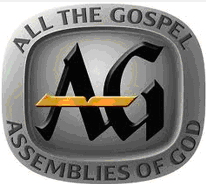 a separate organization, unless it became imperative. But . . . we soon knew that such a course was now imperative. Perhaps, it is also inevitable that our Movement will crystallize as it grows older and larger, and that it will not escape the vices which vast machinery and power have unwittingly fostered in older denominations. But may the dear Lord come before this materializes!” (Goss 1978:chapter 27). The “End Times” and the return of Jesus did not occur as expected by the early Pentecostals, leaving the AG to develop an impressive umbrella organization for its congregations and ministers. The once fluid relational fellowship of its founders would slowly evolve into what Goss and others might have considered a “vast machinery and power,” as it now serves over 12,000 U.S. churches and 35,000 credentialed ministers. It is an organization that for the most part has functioned well, and its workings appear to have the support of the vast majority of contemporary AG pastors (see Poloma 2005).
a separate organization, unless it became imperative. But . . . we soon knew that such a course was now imperative. Perhaps, it is also inevitable that our Movement will crystallize as it grows older and larger, and that it will not escape the vices which vast machinery and power have unwittingly fostered in older denominations. But may the dear Lord come before this materializes!” (Goss 1978:chapter 27). The “End Times” and the return of Jesus did not occur as expected by the early Pentecostals, leaving the AG to develop an impressive umbrella organization for its congregations and ministers. The once fluid relational fellowship of its founders would slowly evolve into what Goss and others might have considered a “vast machinery and power,” as it now serves over 12,000 U.S. churches and 35,000 credentialed ministers. It is an organization that for the most part has functioned well, and its workings appear to have the support of the vast majority of contemporary AG pastors (see Poloma 2005).
In keeping with the original intent of the formative first four General Councils (1914-16) the AG continues to self-identify as a “cooperative fellowship” rather than a denomination. Its formal designation as “The General Council of the Assemblies of God” reflects this value. The national headquarters is said to operate “primarily as a service organization – providing educational curriculum, organizing missions programs, credentialing ministers, overseeing the church’s colleges and seminary, producing communication channels for the churched and non-churched publics, and providing leadership for many national programs and ministries of the Assemblies of God” (“Our Form of Government”). Yet, there is no denying that the AG has developed a vast national organization that provides institutional covering for over three million adherents and thousands of churches and credentialed ministers who are served by its agencies and bureaus.
Permeating AG organization is a blend of congregational and presbyterian church polity. Churches elect their own pastors who, in turn, are responsible to church boards. Ministers are also directly responsible to their local District Council as well as to the Executive General Council. Churches are classified as either being affiliated with the General Council or affiliated with one of over sixty local or ethnic districts. Council affiliated churches enjoy full autonomy; district affiliated churches “have not yet developed to the point where they qualify for full autonomy.” While churches are autonomous congregational entities, the polity governing of ministers and district affiliated churches takes on a presbyterian mode of accountability through the General and Districts Councils and their executive staff.
Administering the General Council are six executive leaders and fourteen non-resident members of the AG Presbytery. Until relatively recently, executive leadership has been all white and all male, but that is slowly changing. In 2007, an African American (Zollie L. Smith Junior) was elected to serve on the executive team as “director of Assemblies of God U.S. Missions.” Over the years, fourteen non-resident members of the Executive Presbytery have been added to represent different factions, nine of which are white male, two Hispanic (elected in 2009 and 1995), one Korean (1999), and one Native American (2007). In 2009, an ordained female minister and missionary to India (Beth Grant) was selected to serve as “Executive Presbyter, representing Ordained Female Ministers,” a non-resident position on the Executive Council. The expanded General Council has created some space for persons of color and non-Euro ethnicity to serve as non-resident members. [In 2011, 68 percent of adherents were reported as being white (a proportion that continues to decrease) and 20 percent Hispanic (and growing in proportion)]. Opportunities for women, despite its long history of ordaining women, remain scarce. Poloma (2005) found in a survey of AG pastors that there was a greater openness to non-white men serving as church leaders than women (regardless of race or ethnicity). Although women have been ordained throughout AG history (with the exception of two years in the 1930s), women were not traditionally granted positions of leadership in the larger organization.
The AG seeks to maintain a loosely knit cooperative network that is increasingly more sensitive to cultural and regional differences. This once Euro-American denomination is making the transition to a culturally diverse body with a wide representation of a growing number of ethnic congregations. At the same time the AG still struggles to ensure a General Council with a leadership structure and polity permeable enough to reflect the charismatic play of the Spirit at work in these diverse congregations. The pragmatism of modern organizations and the primitive qualities of spiritual experiences continue to present dilemmas calling for resolution. The National Office of the Assemblies of God, which includes an administration building, the Gospel Publishing House, and the International Distribution Center, is located in Springfield, Missouri.
ISSUES/CHALLENGES
The Assemblies of God was born out of religious revival, a charismatic moment when powerful prophetic experiences breathed new life into old religion. God seemed to be speaking to humans, and humans sought to respond with words of prophecy and the works of love. In its charismatic moment on Azusa Street old racial taboos were broken and feminine voices could be heard along with the masculine. Baptism in the Spirit was more than a new doctrine that involved glossolalia; it was a fresh experience of divine power and love. Contemporary AG theologians have reminded us that at the heart of the baptism was an empowering love for service (c.f. Macchia 2006) and that this baptism was “poured out on all flesh,” women and men, young and old, white and black people (c.f.Yong 2004). But as in all religious revivals, cultural weeds would soon spring up along side the prophetic wheat.
The Assemblies of God succinctly captures its core spiritual identity through a scriptural passage from the book of Zechariah 4:6, in which the Lord says, “Not by might, nor by power, but by my Spirit.” It provides a key for identifying the complex dilemma the AG has faced since its inception, namely how to balance modern rationality, its culture and organization, with primitive affective charismatic spirituality (Wacker 2001). Is it possible for Pentecostal experiences like tongues, healing, prophecy and miracles to continue to be passed down through the generations as more than doctrine or religious history? Put another way, how successful has AG been in maintaining its self-description as “Fundamentalism (Evangelicalism) with a difference?” Or has it pragmatically morphed into an Evangelicalism that is more doctrine than personal experience? It is with this important question in mind that we will consider three significant dilemmas that challenge the AG as the denomination approaches its centennial anniversary.
The first generation of AG adherents has been described as a loosely-knit congregational network that separated Pentecostals from secular society, other religious groups and often from each other. Convinced that the time was short before Jesus would return to earth, they had their work cut out for them with end-time prophecies proclaiming that the the end was fast approaching. In describing the path from “pilgrims to citizens,” historian Edith Blumhoffer (1993:142) writes: “Like other Pentecostals, early Assemblies of God members professed little interest in contemporary society; they had either not yet glimpsed a broader world or had consciously turned from it. Major political, social and intellectual transitions had significance primarily because they were interpreted through end-time prophetic lens to which Pentecostals subscribed.” These “pilgrims and strangers” on earth eschewed the mundane world in favor of ushering in the coming kingdom of God. This prophectic edge and separatist stance would be tempered by the passage of time during which the Lord seemed to “tarry.” Up until the last decades of the twentieth century, it was common for older “saints” to punctuate any talk of the future with “if Jesus tarries,” as a seeming reminder that they still believed Jesus would be coming soon.
Within a generation after its founding, however, the AG showed signs of pursuing a path antithetical to the expressed
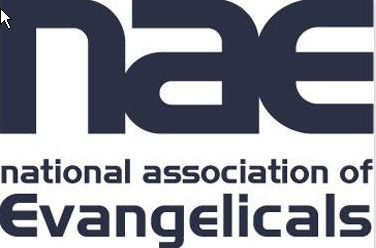 “differences” found in its Pentecostal vision. It joined the newly formed National Association of Evangelicals (NAE) in 1942. Although the early AG, like their Fundamentalist forefathers and mothers, was wed to a literalist interpretation of the Bible and to separation from the larger culture, the AG was never accepted by Fundamentalists precisely because of the “differences,” namely teachings on Spirit baptism, tongue speaking, and divine healing. When more moderate fundamentalists established the NAE, the AG, differences and all, was welcomed into its fold. This union would strengthen the evangelical plank of the Statement of Fundamental Truths, arguably at the expense of the “differences” that marked unique Pentecostal beliefs and practices. In a process that has been called the “routinization of charisma,” more dissonance would develop between Pentecostal doctrine and experience (Poloma 1989; Ziefle 2013).
“differences” found in its Pentecostal vision. It joined the newly formed National Association of Evangelicals (NAE) in 1942. Although the early AG, like their Fundamentalist forefathers and mothers, was wed to a literalist interpretation of the Bible and to separation from the larger culture, the AG was never accepted by Fundamentalists precisely because of the “differences,” namely teachings on Spirit baptism, tongue speaking, and divine healing. When more moderate fundamentalists established the NAE, the AG, differences and all, was welcomed into its fold. This union would strengthen the evangelical plank of the Statement of Fundamental Truths, arguably at the expense of the “differences” that marked unique Pentecostal beliefs and practices. In a process that has been called the “routinization of charisma,” more dissonance would develop between Pentecostal doctrine and experience (Poloma 1989; Ziefle 2013).
The seeds of dissonance between religious experience and organizational doctrine can be gleaned from the 1914 gathering when the loosely knit small group of Pentecostals first came together, desiring a fellowship to curb what they regarded as excesses in the new movement. Within the next two years, doctrinal schism caused by the “New Issue” would strengthen the organization and its doctrine, laying the foundation for the AG to grow into one of America’s top-ten denominations by the early twenty-first century. But aligning with the pragmatic necessity of Pentecostal doctrine and organization, it can be argued, resulted in a muting of the dynamic primal prophetic dimension. Thus emphasis placed on the doctrine by one group of Pentecostals undermined prophetic experiences that briefly united them despite their differences. Three significant issues will be briefly discussed to illustrate the tension between particularistic AG beliefs and practices and the diversity seeded by Pentecostal experiences, including (1) AG organization and revivals; (2) tensions in race/ethnic relations; and (3) the role of women.
AG has faced the continuing issue of revitalizing the spirit of Pentecost. As evident in the presentation of the history of the AG, the denomination was birthed in revival. Even as its early founders insisted on the AG’s not becoming another “dead denomination,” they were fearful of what they regarded as “wildfire” that was much a part of the Azusa Street Revival. They seemed to intuit that whatever else religious experience may be, it can be dangerous to religious institutions. Some of the doctrinal differences, as we have seen, were settled with the adoption of the FST in 1916 and the expulsion of Oneness Pentecostals (as many as one-fourth of the early group) who had a different understanding of the Godhead than the Trinitarian founders. As the decades wore on, the AG would slowly morph from a “fellowship” into a denomination that would seek to protect the organization from the potentially disruptive revivalistic movements, including the New Order of the Latter Rain (the late 1940s), the Charismatic Movement (“Second Wave”) of the 1960s/1970s, and the so-called “Third Wave” revivals of the 1990s extending through the present time. Even when a major revival broke out in one of its own churches in Pensacola, Florida at Brownsville Assembly of God in 1995, denominational reaction was decidedly mixed (see Poloma 1998:2005). More recently Bill Johnson [former AG who pastors the former AG Bethel Church in Redding, California and is the leader of a growing network of revival churches] would amicably resign from the AG. In withdrawing from the AG, Johnson would note: “Our call feels unique enough theologically and practically from the call on the Assemblies of God that this change is appropriate” (Poloma and Green 2010:102).
One particularly significant account of the “struggle for the soul of a [AG) movement” involves the story of David du Plessis, an
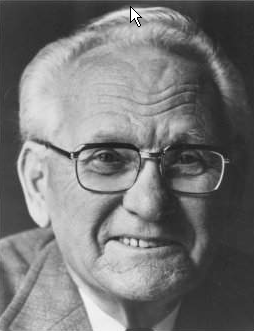 evangelist from South Africa who joined the AG when he moved to the United States in the middle of the twentieth century (see Ziefle 2013). Known as “Mr. Pentecost” by those in the “second wave” of Pentecostal revival known as the Charismatic Movement, du Plessis believed that church unity was a primary marker of the move of the Holy Spirit, the same unity of spirit that he believed characterized the earliest years of the Azusa Street Revival. Having the ear of many leaders of the Charismatic Movement, du Plessis spread the Pentecostal gospel of Spirit baptism and involved himself in ecumenism, a movement that was anathema to evangelicals and to the AG. His involvement in the World Council of Churches resulted in his being defrocked by his adopted denomination in 1962; his ministerial credentials would not be restored until 1980. Forced to leave the AG because of his ongoing work with Second Wave leaders (including Roman Catholics) left du Plessis on the margins even when he was reinstated as an AG minister toward the end of his life.
evangelist from South Africa who joined the AG when he moved to the United States in the middle of the twentieth century (see Ziefle 2013). Known as “Mr. Pentecost” by those in the “second wave” of Pentecostal revival known as the Charismatic Movement, du Plessis believed that church unity was a primary marker of the move of the Holy Spirit, the same unity of spirit that he believed characterized the earliest years of the Azusa Street Revival. Having the ear of many leaders of the Charismatic Movement, du Plessis spread the Pentecostal gospel of Spirit baptism and involved himself in ecumenism, a movement that was anathema to evangelicals and to the AG. His involvement in the World Council of Churches resulted in his being defrocked by his adopted denomination in 1962; his ministerial credentials would not be restored until 1980. Forced to leave the AG because of his ongoing work with Second Wave leaders (including Roman Catholics) left du Plessis on the margins even when he was reinstated as an AG minister toward the end of his life.
The pragmatic evangelicalization of the AG at the expense of its primitive spirituality has long been noted (c.f. Poloma 1989; Poloma and Green 2010; Ziefle 2013), but this observation is only part of the story. The AG in the United States combines its Presbyterian polity with Congregational government allowing for the congregational diversity as reflected in the different types of congregations and rituals discussed in an earlier section. Although the Evangelical AG congregations arguably may be the predominant type, it is important to assess the growing number of Hispanic and other ethnic churches that are commonly categorized as Traditional AG in beliefs and rituals (Poloma and Green 2010). Rooted in its history a cultural dynamic is at work that is transforming the formerly predominantly Euro-American denomination with strong rural southern roots into an increasingly multicultural one with a diverse urban presence.
AG has also faced racial/ethnic tensions through its history. “The evidence is clear:,” says Don Meyer, AG leader and president of one of its universities, “The Assembles of God has not had a good track record on race. Whether one looks at this issue ecclesiastically, theologically, sociologically, or biologicallty, we have been ‘weighed in the balances and found wanting’” (Newman 2007:1). From its beginning days, the AG saw itself as a “white denomination,” as it disengaged from the Church of God in Christ (COGIC), the fifth largest denomination in the U.S. African Americans who sought ordination within the AG were officially referred to the “colored organization” (COGIC).
It was not until 1994 in what was known as the “Memphis Miracle” that the AG officially disavowed its racist past. In what was 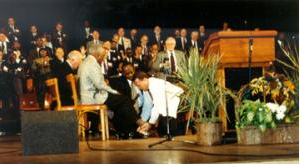 described as a “historic gesture,” General Superintendant Thomas Trask (the highest-ranking official in the AG) participated in a ceremonial footwashing (Newman 2007) at a conference of black and white Pentecostal leaders in Memphis. Prophecies were given about black and white unity, as a white AG pastor (Donald Evans) came forward and explained that “the Lord had called him to wash the feet of a black leader (Bishop Clemmons) as a sign of repentance” (Synan 2010). It was also at the Memphis gathering that the all-white Pentecostal Fellowship of North American (PFNA) was disbanded to be replaced with the integrated Pentecostal Charismatic Churches of North America (PCCNA).
described as a “historic gesture,” General Superintendant Thomas Trask (the highest-ranking official in the AG) participated in a ceremonial footwashing (Newman 2007) at a conference of black and white Pentecostal leaders in Memphis. Prophecies were given about black and white unity, as a white AG pastor (Donald Evans) came forward and explained that “the Lord had called him to wash the feet of a black leader (Bishop Clemmons) as a sign of repentance” (Synan 2010). It was also at the Memphis gathering that the all-white Pentecostal Fellowship of North American (PFNA) was disbanded to be replaced with the integrated Pentecostal Charismatic Churches of North America (PCCNA).
The Memphis Miracle has done little to bring African Americans into the AG fold, but it can be regarded as a marker for the AG losing the questionable distinction of being an “all-white” American denomination. Its once nearly lily white constituency is now a multi-cultural one that reflects recent immigration patterns, especially the growth of the Hispanic population in the U.S. As of January, 2012, there were more than 2,400 officially recognized Hispanic organizations in the General Council of the Assemblies of God, USA, with 12 Hispanic districts that include more than 3,300 ministries (“Office of Hispanic Relations” n.d.). The figures for Hispanics represent some 20 percent of AG adherents, while only 2.7% of adherents are black (mostly Caribbean or recent African immigrants), 4 percent are Asian or Pacific Islanders, and 1.5% are of Native American heritage (“Statistics of the Assemblies of God” 2007)
Despite these demographic changes, the leadership of the General Assembly has tended to be disproportionately white, although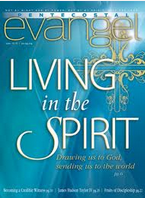 moves have been made within the past decade to establish closer relations with the Hispanic churches. In 2006, the Office of Hispanic Relations was established as part of the National Leadership and Resource Center, with a Spanish version of the AG publication of Pentecostal Evangel and a Spanish website. It should be noted that ethnic churches enjoy the autonomy inherent in the AG’s congregational polity. Furthermore, these congregations are often founded and led by indigenous ministers involved in what can be termed “reverse missiology.” Early in its history of an aggressive missions program, the AG departed from the colonial model of other denominations, “establishing mission stations as beachheads in other nations, led by missionaries, and with national pastors on their payroll” (Molenaar, n.d.:1). Instead, the AG sent out its missionaries and trained indigenous leaders who have developed autonomous AG churches throughout the world. As immigrants have come from South and Central America, Africa, Asia, and other places to the U.S., they have been increasingly served by their indigenous clergy.
moves have been made within the past decade to establish closer relations with the Hispanic churches. In 2006, the Office of Hispanic Relations was established as part of the National Leadership and Resource Center, with a Spanish version of the AG publication of Pentecostal Evangel and a Spanish website. It should be noted that ethnic churches enjoy the autonomy inherent in the AG’s congregational polity. Furthermore, these congregations are often founded and led by indigenous ministers involved in what can be termed “reverse missiology.” Early in its history of an aggressive missions program, the AG departed from the colonial model of other denominations, “establishing mission stations as beachheads in other nations, led by missionaries, and with national pastors on their payroll” (Molenaar, n.d.:1). Instead, the AG sent out its missionaries and trained indigenous leaders who have developed autonomous AG churches throughout the world. As immigrants have come from South and Central America, Africa, Asia, and other places to the U.S., they have been increasingly served by their indigenous clergy.
The congregational polity that has promoted indigenous leadership, however, has not yet been translated into leadership within the AG Executive Council and its headquarters in Springfield, Missouri. The history of the World Assemblies of God Fellowship may be a predictor of things to come if the growing ethnic constituency is not more fully acknowledged on the national level. The roots of the World Assemblies of God Fellowship (with over 65 million adherents within over 150 national fellowships), as we have noted earlier, was American and guided by the US church. This would change as the twentieth century came to a close; the AG USA is but one equal member of this global organization. It is conceivable that without increased recognition and representation on the national level, ethnic districts may seek a more autonomy and equality with the largely Euro-American leadership in the denomination.
Finally, the history of women in Pentecostalism has been aptly characterized as “complex and contradictory” ( Griffith and Roebuck 2002:1203). On one hand, a case can be made for gender equality, citing the fact that the AG ordained women decades before women were ordained in mainline denominations. On the other hand, there have always been limitations, at times formally defined but primarily culturally and structurally proscribed. Dr. George O. Wood (2001), who as a district leader in California and more recently as the AG’s General Superintendent has been highly supportive of AG ordination of women, succinctly describes the early history as follows:
At the organizational meeting of the Assemblies of God in 1914, women were granted the right of ordination as evangelists and missionaries, but not as elders. Ordained women were at first not permitted to vote in the General Council since such was regarded as an eldership function. However, women were accorded voting rights beginning with the 1920 General Council, the same year the 19 th Amendment was adopted which granted women in the United States the right to vote.
The ban on eldership meant that ordained women should not serve as pastors, marry people, and administer the ordinances of water baptism and the Lord’s supper. However, the Assemblies of God had ordained women fulfilling all these functions anyway. In 1922, then general superintendent E.N. Bell, writing on behalf of the Executive Presbytery to ordain women, wrote: “It has nevertheless been understood all along that they could do these things when some circumstance made it necessary for them to so do. . . . The Executive Presbytery authorized the Credential Committee to issue new credentials to all our ordained women who are actually preaching the Word just the same as ordained men do, and that these credentials should state these women are authorized to do these things when necessary.” So sensitive and potentially divisive was that decision that Brother Bell requested at the end of his letter to ordained women: “TAKE NOTICE: This letter is not to go out of your personal possession.”
Aimee Semple McPherson had been ordained in the AG as an “evangelist” and was one of many women functioning as a fully 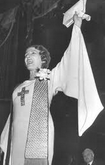
ordained minister despite the proscriptions cited above. She was highly popular in Pentecostal circles and would withdraw from the AG in 1922, the same year as Bell’s letter, as she founded the International Church of the Four Square Gospel. The ordination issue continued to simmer until it came to a head in 1933 when the General Council formally limited the ordination of women to “evangelist.” Although the right of ordained women to officiate the ordinances “when such acts are necessary” would be reinstated in 1935, “the patterns of limitation continued to be generally accepted” (Griffith and Roebuck 2002:1205).
With the rise of feminism in the United States in the 1970s, the AG was intent on distancing itself from advocating equal rights for women. With this antipathy toward feminist issues, the percent of women ministers in the AG slowly but steadily decreased in the AG during the 1970s and 1980s (Pulliam 2009). The new millennium has seen an increase of the number and percent of women ministers, with the percent of women ministers increasing from 14 percent to nearly 21 percent in 2010. The vast majority of the 7,000 plus ordained women, however, serve the denomination on staffs of churches or as world missionaries. Women serving as lead pastors of congregations continue to be few and far between. Beth Grant, a missionary to India, was elected in 2009 to serve on the Executive Presbytery as “Executive Presbyter, representing Ordained Female Ministers.”
General Superintendent George Wood has been a leading voice in promoting equality for women in the AG. Growing up with a 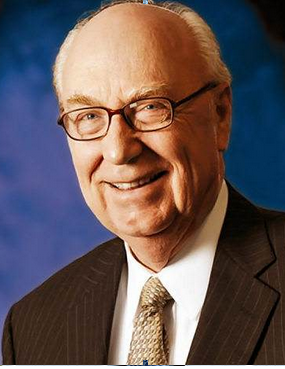 mother who was ordained in 1924, Wood has reminded adherents that “the credentialing of women in our Fellowship is not some late popular cultural fad.” Wood (n.d.) explains: “Our early pioneers were convinced that Scripture meant what it said when the promise of Pentecost was realized: In the last days, God says, ‘I will pour out my Spirit on all people. Your sons and daughters will prophesy. . .Even on my servants, both men and women, I will pour out my Spirit in those days, and they will prophesy’ (Acts 2:17,28).”
mother who was ordained in 1924, Wood has reminded adherents that “the credentialing of women in our Fellowship is not some late popular cultural fad.” Wood (n.d.) explains: “Our early pioneers were convinced that Scripture meant what it said when the promise of Pentecost was realized: In the last days, God says, ‘I will pour out my Spirit on all people. Your sons and daughters will prophesy. . .Even on my servants, both men and women, I will pour out my Spirit in those days, and they will prophesy’ (Acts 2:17,28).”
The Spirit may have been poured out on all, but women have always been on a short leash. In its charismatic moment, women played a major role in revivals as did people of color. But as the denomination aligned with Evangelicalism, arguably the AG it took on its pragmatic culture and modern issues at the cost of Pentecostalism’s prophetic thrust. Whether or not the AG can continue to effectively balance its primitive spirituality with its pragmatic orientation can be monitored through its openness to new waves of pentecostal revival, to its ability to learn from the charismatic spirituality found in immigrant churches, and to granting equality to its prophetic women.
REFERENCES
Assemblies of God. n.d. “Statement of Fundamental Truths.” Accessed from http://ag.org/top/Beliefs/Statement_of_fundamental_truths/sft_short.cfm on 5 February 2013)
Bartleman, Frank. (2012; 1925). Azusa Street. How Pentecost Came to Los Angeles. Kindle Edition: Jawbone Digital. Accessed from http://www.JawboneDigital.com on 20 April 2013.
Blumhofer, Edith L. 1993. Restoring the Faith. The Assemblies of God, Pentecostalism, and American Culture. Chicago: University of Illinois Press.
Blumhofer, Edith L. 1989. The Assemblies of God: A Chapter in the Story of American Pentecostalism, Volume 1. Springfield, MO: Gospel Publishing House.
Blumhoffer, E. L. and C. R. Armstrong. 2002. “Assemblies of God.” Pp. 333-41 in International Dictionary of Pentecostal Charismatic Movements, edited by Stanley M. Burgess and Eduard M. Van Der Mass. Grand Rapids, MI: Zondervan.
Goss, Ethel E. 1958. The Winds of God. The Story of the Early Pentecostal Days (1901-1914) in the Life of Howard A Goss. A Christian Reality Books Pentecostal History Classic Reprint. Kindle Version.
Griffith, R.M. and D. Roebuck. 2002. “Role of Women.” Pp. 1203-09 in The New International Dictionary of Pentecostal and Charismatic Movements, edited by Stanley M. Burgess and Eduard M. Van Der Maas. Grant Rapids, MI: Zondervan.
Hollenweger, Walter J. 1997. Origins and Developments Worldwide. Peabody, MA: Hendrickson Publishers.
Macchia, Frank D. 2006. Baptized in the Spirit. A Global Pentecostal Theology. Grand Rapids, MI: Zondervan.
McClymond, Michael, ed. 2007. Encyclopedia of Religious Revivals in America. Volume 2. Primary Documents. Westport CT: Greenwood Press.
Molenaar, William. n.d. “The World Assemblies of God Fellowship. United in the Missionary Spirit.” Accessed from www.worldagfellowship.org on 29 January 2013).
Newman, Joe. 2007. Race and the Assemblies of God Church. The Journey from Azusa Street to the “Miracle of Memphis” Amherst, NY: Cambria Press.
O’Dea, Thomas F. and Janet Aviad O’Dea. 1983. The Sociology of Religion. Second Edition. Englewood Cliffs, NJ: Prentice Hall.
“Office of Hispanic Relations.” n.d. Assemblies of God. Accessed from http://ag.org/top/Office_of_Hispanic_Relations/index.cfm on 20 April 2013.
Poloma, Margaret M. 2005. “Charisma and Structure in the Assemblies of God: Revisiting O’Dea’s Five Dilemmas.” Pp. 45-96 in Church, Identity, and Change: Theology and Denominational Structures In Unsettled Times, edited by David A. Roozen and James R.; Nieman. Grand Rapids, MI: Eerdmans.
Poloma, Margaret M. 2003. Main Street Mystics: The Toronto Blessing and Reviving Pentecostalism. Walnut Creek, CA: AltaMira Press.
Poloma, Margaret M. 1998. “The Spirit Movement in North America at the Millennium: From Azusa Street to Toronto, Pensacola and Beyond.” Journal of Pentecostal Theology 12:83-107.
Poloma, Margaret M. 1989. The Assemblies of God at the Crossroads: Charisma and Institutional Dilemmas. Knoxville, TN: The University of Tennessee Press.
“Our Form of Government.” n.d. Assemblies of God. Accessed from http://ag.org/top/about/structure.cfm on 20 April 2013.
Poloma, Margaret M. and John C. Green. 2010. The Assemblies of God. Godly Love and the Revitalization of American Pentecostalism. New York: New York University Press.
Pulliam, Sarah. 2009. “Women Pastors Remain Scarce.” Christianity Today. Accessed from http://www.christianitytoday.com/women/2009/august/women-pastors-remain-scarce.html on 20 April 2013.
Robeck, Cecil M., Jr. 2006. Azusa Street. Mission and Revival. The Birth of the Pentecostal Movement. Nelson Reference & Electronic.
Robeck, Cecil M. Jr. 2003.“An Emerging Magisterium? The Case of the Assemblies of God.” Pneuma 25:165-215.
Rybarczyk, Edmund. 2007. “American Pentecostalism: Challenges and Temptations.” Pp. 1-13 in The Future of Pentecostalism in the United States, edited by E. Patterson and E. Rybarczyk. New York: Lexington Books.
Seymour, William. 2012. 1906-1908. The Azusa Papers (written from September 1906-May, 1908). Jawbone Digital. Accessed from http://www.JawboneDigital.com on 20 April 2013.
“Statistics of the Assemblies of God.” 2007. Assemblies of God. Accessed from http://ag.org/top/about/statistics/Statistical_Report_Summary.pdf on 20 April 2013.
Synan, Vinson. 2010. “ Memphis 1994: Miracle and Mandate.” Accessed from www.pcna.org/about_history.htm on 18 April 2013.
Wacker, Grant . 2001. Heaven Below. Early Pentecostals and American Culture. Cambridge, MA: Harvard University Press.
Wood, George O. 2001. “Exploring Why We Think The Way We Do About Women In Ministry.” Enrichment Journal. Accessed from http://enrichmentjournal.ag.org/200102/008_exploring.cfm on 20 April 2013.
Wood, George O. n.d. “Why Credentials Are Important for Women Ministers.” The Nework. A Called Community of Women. Accessed from http://ag.org/wim/0509/0509_credentials.cfm on 20 April 2013.
Yong, Amos. 2004. The Spirit Poured Out on All Flesh. Pentecostalism and the Possibility of Global Theology. Grand Rapids, MI: Baker Academic.
Ziefle, Joshua R. 2013. David du Plessis and the Assemblies of God. The Struggle for the Soul of a Movement. Boston: Brill.
Post Date:
20 April 2013
ASSEMBLIES OF GOD VIDEO CONNECTIONS
